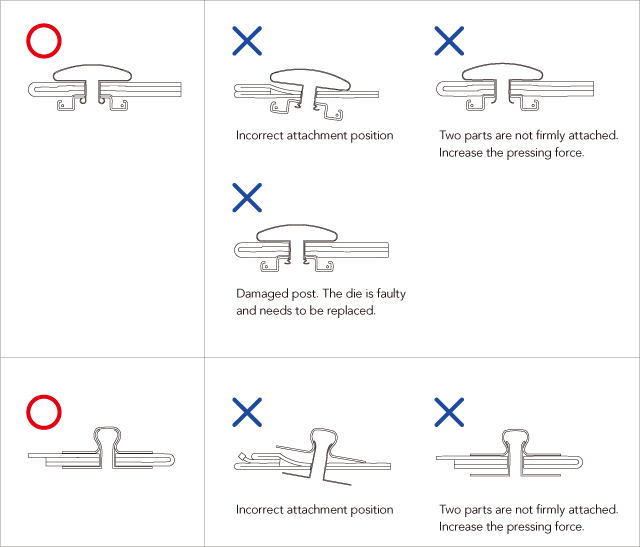Catalog
Home » Catalog » Attachment Overview
Attachment Overview
Please contact your Hisanaga representative for detailed guidance
Material Specifications
- Choose the appropriate snap type, size and strength based on the material specifications, including type, thickness and density.
- Additional material ("packing") might be required, depending on attachment location and material specification.
- Fabrics processing flame-retardant or wrinkle-free treatments can potentially damage snaps such as tarnishing the surface of the snap.
- When finishing process including high heat press or bleaching is applied on the fabrics after snaps are attached, the test is required in advance if there is any damage on the surface of snap.
- Snaps should be lacquered if attached to leather or materials made with down feathers.
- Fabrics and products should be tested in advance in order to avoid any tarnish or defect.
Snap Surface Treatment
Normally, clear coating will minimize the risk of residual chemicals damaging the snap's surface treatment. However, special attention is required under the following conditions due to the potential risk of corrosion, tarnish, stress corrosion cracking and defect.:
- When leather/artificial leather manufacturing processes including tanning, dyeing, adhesion etc., leave residual chemicals.
- When fabric/garment treatments such as bleaching, dying, softening, heat press, fire retardants or wrinkle-free leave residual chemicals on the front, inside and back of the material.
- While chemicals such as formalin, ammonia, tannic acid and chromic acid are remained on fabrics/garments in the form of residue, when the finished products are high-steam pressed and stored in air-tight packaging immediately for a long period of time.
Please raise any concerns with your Hisanaga representative and we will assist with compatibility testing with your material samples.
Attachment Location
- Snaps can only be attached on materials with even thickness. Do not attach snaps on fabrics with uneven thickness.
- Be careful when you attach the snap on the folded fabrics and interfacings.
- To avoid damage to stitching, do not attach snaps on stitch lines.
Attachment Equipment
- Always use the correct press machine and die combination for each snap model.
- Snaps will not be correctly attached if the press machine or die is worn or damaged.
- Fit the center of both upper and lower side of die and attach to the press machine firmly. Check if there is any loose die before, after and during the attachment process.
- Test the press machine without fabric before use to check the machine and die.
- Ensure the snap can't be rotated by fingers after attachment.
Illustrations
